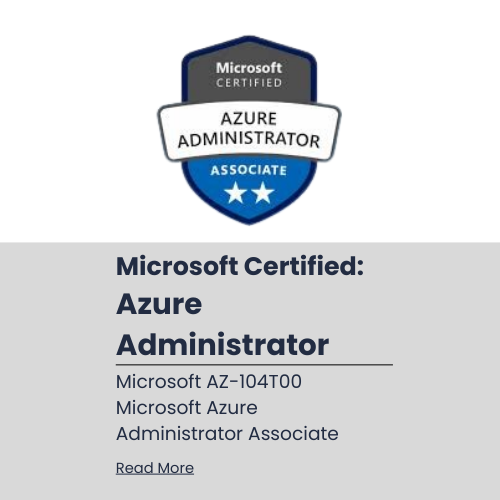
Learning Objectives:
Implement and manage Azure compute resources (VMs, App Services, and Azure Functions).
Manage Azure Storage accounts and implement storage solutions.
Configure and manage Azure virtual networks, subnets, and network security groups.
Implement and manage Azure identity and access management solutions.
Manage Azure subscriptions, resources, and governance.
Implement Azure monitoring and backups to ensure resource availability and business continuity.
Manage security and compliance in the Azure environment.
Course Outline:
Introduction to Azure Administration
Topics Covered:
Introduction to Microsoft Azure and Cloud Computing
Overview of Azure Services and Solutions
Introduction to the Azure Portal and Azure Resource Manager
Azure Subscriptions and Azure Resource Groups
Basic Azure Identity and Access Management (IAM)
Laboratory Activity 1:
Lab Objective: Create a Microsoft Azure account and navigate the Azure Portal
Steps:
Example:
• Create a Windows Server 2019 virtual machine with a public IP and connect to it via Remote Desktop.
Implementing and Managing Azure Compute Resources
Topics Covered:
Azure Virtual Machines (VMs)
Deploying and configuring VMs
Configuring VM Availability Sets
Implementing Virtual Machine Scale Sets
Azure App Services and Azure Functions
Introduction to Azure App Services
Deploying and managing Azure Functions
Laboratory Activity 2:
Lab Objective: Deploy and configure a Virtual Machine and an App Service.
Steps:
Example:
• Deploy a Node.js web application to Azure App Services and link it to an Azure SQL Database.
Week 3: Managing Azure Storage Solutions
Topics Covered:
Azure Storage Types (Blob, Disk, File, Queue)
Understanding Blob Storage and managing blobs
Working with Azure Managed Disks and Azure Files
Implementing Azure File Sync
Storage Security (Encryption, Shared Access Signatures)
Laboratory Activity 3:
Lab Objective: Create and manage Azure Storage accounts and configure access.
Steps:
Example:
• Upload a file to Azure Blob Storage and create a SAS URL to share the file securely.
Week 4: Implementing Virtual Networks and Network Security
Topics Covered:
Introduction to Virtual Networks (VNet)
Subnets, IP Addressing, and DNS
Network Security Groups (NSGs)
Virtual Network Peering
Azure Load Balancer and VPN Gateway
Configuring Load Balancer for high availability
Setting up Site-to-Site VPN and Point-to-Site VPN
Laboratory Activity 4:
Lab Objective: Implement Virtual Networks and Network Security.
Steps:
Example:
• Set up a basic 2-tier architecture with a Virtual Network, a load balancer, and two VMs for high availability.
Managing Azure Active Directory and Identity Services
Topics Covered:
Introduction to Azure Active Directory (Azure AD)
Managing Azure AD Users and Groups
Configuring Azure AD Roles and Permissions
Implementing Identity Federation
Azure AD Connect and Hybrid Identity
Managing Single Sign-On (SSO) and Multi-Factor Authentication (MFA)
Laboratory Activity 5:
Lab Objective: Configure Azure Active Directory and manage users.
Steps:
Example:
• Set up an Azure AD tenant, add users, assign roles, and configure MFA for an admin user.
Managing Azure Governance and Resource Management
Topics Covered:
Resource Management with Azure Resource Manager (ARM)
Working with ARM Templates and Bicep
Implementing Resource Locks and Tagging
Azure Policies and Blueprints
Enforcing Governance using Azure Policies
Introduction to Azure Blueprints
Azure Cost Management and Billing
Laboratory Activity 6:
Lab Objective: Implement governance using policies and resource tagging.
Steps:
Example:
• Deploy an Azure resource group with a specific tag using an ARM template and enforce a policy that restricts certain VM sizes.
Implementing Monitoring and Backups
Topics Covered:
Azure Monitor and Log Analytics
Configuring Monitoring and Alerts for resources
Using Log Analytics to query and analyze logs
Backup Solutions in Azure
Configuring Azure Backup for VMs and Files
Using Recovery Services Vaults for disaster recovery
Laboratory Activity 7:
Lab Objective: Implement Azure monitoring and backup solutions.
Steps:
Example:
• Configure an Azure Monitor alert for high CPU usage on a Virtual Machine and schedule daily backups for the VM.
Week 8: Managing Security and Compliance in Azure
Topics Covered:
Security Center and Azure Defender
Configuring Security Center for threat protection
Implementing Azure Defender for cloud security
Azure Security Best Practices
Security best practices for networking, storage, and compute resources
Compliance certifications (GDPR, HIPAA, etc.)
Laboratory Activity 8:
Lab Objective: Implement security and compliance solutions in Azure.
Steps:
Example:
• Use Azure Security Center to identify security vulnerabilities in a resource and implement Azure Defender to monitor threats.
Assessment & Certification:
Labs: Weekly hands-on lab activities to practice Azure administrative skills.
Final Exam: A comprehensive multiple-choice exam covering all topics discussed in the course.
Certification: Upon successful completion, participants will receive a course certificate.
Copyright 2025 by TechEd IT Solutions. All right reserved Privacy Policy Terms & Conditions